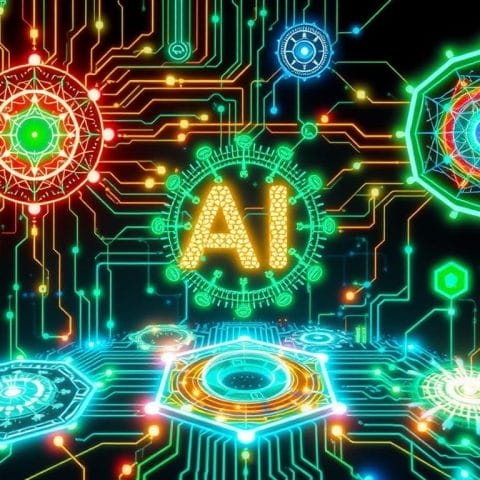Organizations are working hard to make workplaces more inclusive and fair. Artificial intelligence (AI) is playing a big role in this effort. AI simulations are changing how we learn about cultural sensitivity, making training more personal and effective.
There have been many examples of AI bias. For instance, facial recognition tech often struggles with darker skin tones. Also, AI in criminal justice and hiring can unfairly treat minority groups. It’s important to have diverse teams work on AI to avoid these biases.
AI simulations help make workplaces more inclusive. They let employees try out different scenarios and see things from other perspectives. This way, they can learn about their own biases and change their behavior.
Key Takeaways
- AI simulations provide personalized and immersive experiences for diversity and inclusion training.
- Addressing AI bias is key to fair and equitable outcomes in areas like facial recognition, criminal justice, and hiring.
- Having diverse teams work on AI is vital to reduce biases in the technology.
- AI simulations help employees explore real-world scenarios and get feedback, leading to better self-awareness and behavior.
- Using AI for diversity training can help create more inclusive and fair workplaces.
Understanding Diversity Awareness in Today’s Society

Diversity in organizations is key for creativity, better decision-making, and innovation. But, progress in STEM fields, like computing and engineering, has been slow. Barriers from power, privilege, and oppression make it hard for marginalized groups to succeed. Interventions that focus on identity, motivation, and belonging are needed.
The Importance of Diversity in Organizations
Research shows companies with more gender diversity are 25% more profitable. Diversity also boosts team productivity, as seen at Salesforce, which saw a 35% increase after focusing on diversity and inclusion.
Current Challenges in Diversity Awareness
Despite the benefits, STEM fields are slow to diversify. Issues like bias mitigation techniques and lack of multicultural perspectives hold back marginalized groups. Solutions must tackle these systemic problems to achieve true inclusivity and equity.
| Challenge | Impact | Solution |
|---|---|---|
| Algorithmic Bias | AI mimics blind recruitment processes but with added rigor, reducing human bias. | AI helps level the playing field for all applicants by relying on objective criteria. |
| Biased Evaluations | AI removes biases and expectations in assessing employees’ skills and readiness for higher positions. | AI algorithms randomly assemble diverse interview panels, ensuring fair evaluations. |
| Lack of Diversity | Machine learning identifies high-potential applicants for specific roles objectively, eliminating identifiers such as race, ethnicity, sexual orientation, and age. | AI-based systems evaluate employee salaries objectively, ensuring fair compensation and transparency. |
By tackling these challenges with diversity training and education, companies can create a more inclusive and fair work environment. This allows diverse teams to reach their full capacity.
What are AI Simulations?

AI simulations use artificial intelligence to make learning simulations better and more accessible. They create virtual worlds that feel real. This is done by using AI to make assets, automate tasks, and create natural-sounding voices.
Definition and Key Features
AI simulations use artificial intelligence to improve simulations in many areas. They have key features that make them stand out:
- AI-generated assets: AI can make 3D models, animations, and environments. This saves time and effort compared to doing it by hand.
- Streamlined repetitive tasks: AI can handle tasks like creating scenarios and adjusting parameters. This makes developing simulations faster.
- Diverse and natural-sounding narrations: AI can create voiceovers and dialogues that sound like real people. This makes simulations more engaging and relatable.
Applications of AI Simulations in Different Fields
AI simulations are useful in many fields. They can be used in:
| Industry | Applications |
|---|---|
| Education | Immersive learning experiences, virtual experiments, and personalized training programs. |
| Healthcare | Simulated medical procedures, crisis response training, and empathy-building exercises. |
| Corporate Training | Soft skills development, customer service scenarios, and leadership training. |
AI simulations create immersive virtual environments and use inclusive AI modeling. They help users learn through experience. This builds understanding and skills tailored to their needs and goals.
How AI Simulations Foster Diversity Awareness
AI simulations create immersive experiences that help us understand different perspectives. They offer real-world scenarios and role-playing, letting us see various cultural contexts and challenges. AI tailors learning to fit each person’s needs and learning style.
Immersive Experiences and Empathy
AI simulations take us into realistic, interactive worlds. These experiences help us feel empathy towards diverse cultures and views. By exploring different scenarios, we learn to see things from others’ perspectives, deepening our appreciation for diversity.
Real-World Scenarios and Role-Playing
AI simulations are more than just learning. They offer interactive, real-world scenarios and role-playing. We can practice cross-cultural communication, learning essential skills like cultural sensitivity and conflict resolution.
AI makes these simulations more affordable and accessible. It helps users tailor their learning to fit their style, making learning more engaging.
Even with AI’s advancements, human actors are key in simulation-based learning. They add authenticity and depth to the experience. The future of AI in simulations includes giving personalized feedback, improving learning even more.
AI simulations help organizations build a culture of diversity awareness. They empower employees to handle cross-cultural challenges with empathy and effective communication.
The Benefits of Using AI for Diversity Training
AI-powered diversity training brings many benefits to organizations. It helps create a more inclusive and fair workplace. Companies can offer learning experiences that connect with employees from all backgrounds. They also get feedback to improve their diversity efforts.
Engaging Learning Experience
AI-driven training is personalized and fun. It uses simulations and games to teach employees. This way, they learn to overcome biases and be more inclusive.
This method keeps employees interested and committed. It makes the workplace more diverse and welcoming.
Measurable Outcomes and Feedback
AI helps track how well training works. It gives companies useful data to improve their strategies. This data helps make better decisions and focus on what really works.
Using diversity data analytics and equitable AI frameworks makes training more effective. It helps address specific challenges in the workplace. This builds trust and accountability in diversity efforts.
“AI-powered diversity training has the power to change how we include everyone at work. It uses technology to make learning more engaging and impactful. This leads to a workplace where everyone feels valued and belongs.”
Real-World Examples of AI Simulations in Diversity Training
Companies and non-profits have used AI simulations to improve diversity training. These efforts aim to create inclusive workplaces. They show how AI can make training more immersive, reduce bias, and enhance communication across cultures.
Successful Case Studies in Corporations
Google’s “Unconscious Bias @ Work” program uses interactive scenarios and AI feedback. It helps employees recognize and tackle their unconscious biases. Through these simulations, people learn how biases affect decisions and interactions at work.
IBM has made big strides in diversity and inclusion. In 2023, it started 25 new Business Resource Groups (BRGs). It also ensures all employees take annual training on business conduct. IBM’s AI system tailors learning to each person, making the culture more inclusive.
Lessons Learned from Non-Profit Organizations
- Procter & Gamble works to promote diversity, equity, and inclusion. It aims to remove bias in communications and foster inclusive leadership. It also partners with others to tackle systemic biases.
- Microsoft focuses on creating a more inclusive culture. It encourages employees to be better allies and promotes diversity through learning. It also emphasizes inclusive leadership and allyship.
| Company | Key Initiatives | Impact |
|---|---|---|
| Unconscious Bias @ Work program using AI-driven scenarios | Increased employee awareness and motivation to address biases | |
| IBM | Personalized diversity and inclusion training using AI | Fostered a more inclusive culture through tailored learning |
| Procter & Gamble | Eliminating bias in communications, cultivating inclusive leadership | Accurately portrayed diverse groups and developed inclusive leaders |
| Microsoft | Promoting diversity, inclusion, and allyship through continuous learning | Emphasized inclusive leadership and taught employees to be better allies |
These examples show the value of customization and continuous improvement in AI training. Real actors add authenticity and depth to these simulations. They bring unique experiences that AI might not fully capture.
Key Components for Effective AI Simulations
As more companies use AI simulations in their diversity training, it’s key to know what makes them work well. Customization and relevance, along with easy-to-use interfaces, are essential.
Customization and Relevance
AI simulations need to fit the specific needs and challenges of each company. They should use diverse data, bias mitigation techniques, and inclusive AI modeling. This ensures the training is real and effective for employees.
User-Friendly Interfaces
The success of AI simulations also depends on how easy they are to use. Easy-to-navigate interfaces help keep employees engaged and learning. Adding real-life actors and interactive stories makes the training more realistic and memorable.
| Key Statistic | Benefit |
|---|---|
| AI integration has led to a reduction in costs and labor associated with simulation creation. | Increased cost-effectiveness and scalability of diversity training programs. |
| AI advancements have enabled more diverse and natural-sounding narrations in simulations. | Improved authenticity and engagement, fostering deeper learning experiences. |
| Utilizing AI in simulations has made production processes more cost-effective. | Allows organizations to allocate resources more efficiently towards diversity initiatives. |
By focusing on these key areas, companies can create AI simulations that boost diversity awareness. They help build inclusive workplaces and improve diversity and inclusion efforts.
Implementing AI Simulations in Your Organization
Organizations looking to boost diversity awareness can use AI simulations. These tools help build empathy and understanding. They also offer insights to make real changes. Here’s how to start using AI simulations in your workplace:
Steps to Get Started
- First, understand your organization’s diversity needs. Get feedback from employees and look at diversity data.
- Then, find the right people to help. This includes leaders, HR, and diverse employee groups.
- Look for AI simulation platforms that fit your goals. Make sure they offer fair and customizable tools.
- Create content that shows your organization’s unique challenges and views.
- Make sure you have enough resources. This means time and money for a successful launch.
Involving Stakeholders and Training Staff
Getting a variety of people involved is key. Include experts from different areas like business, tech, and government. This way, your simulations will tackle real issues and offer valuable insights.
It’s also important to teach your team how to use the AI data. They need to know how to use the simulations and understand the results. This helps create a more welcoming and fair workplace. Keep training your team to get the most out of AI simulations.
Using AI simulations in your workplace needs careful planning. Match your diversity goals with AI tools, involve the right people, and train your team well. This way, you can make a big difference in your workplace’s diversity and inclusion.
Measuring the Impact of AI Simulations on Diversity Awareness
To see if AI simulations work in teaching about diversity, we need a detailed plan. We should use strong tools and keep improving. This way, we can really understand how these experiences change things.
Tools and Metrics for Evaluation
Figuring out if AI simulations help with diversity awareness is complex. We use tests before and after, watch how people act, and look at diversity numbers over time. These methods help us see how the simulations change people’s views and actions.
- Pre- and post-training assessments: Check if people know more about diversity and inclusion.
- Behavioral observations: Watch how people interact and make decisions during the simulations.
- Organizational diversity metrics: Look at how diverse the workplace is over time.
Continuous Improvement Strategies
To keep AI simulations effective, we need to keep making them better. We should use data and feedback from users. This way, we can make the training more relevant and effective for everyone.
| Metric | Description | Ideal Outcome |
|---|---|---|
| Diversity Representation | The percentage of underrepresented groups in the organization | Increase in representation of diverse groups over time |
| Inclusion Index | A measure of employees’ sense of belonging and participation | Increase in the Inclusion Index score |
| Bias Reduction | The decrease in unconscious biases among employees | Measurable reduction in implicit biases |
By making AI simulations better based on data and feedback, we can keep our diversity training effective. This approach helps create a fair and welcoming workplace for everyone.
Future Trends in AI and Diversity Training
AI is changing many industries, and diversity training is no exception. New tech like virtual and augmented reality will make training more real and engaging. These tools let people experience life from different perspectives, helping them understand others better.
Emerging Technologies in Diversity Awareness
In the next ten years, AI will help spot and fix bias in real time. Smart algorithms will check how people interact and give feedback to help them see their biases. AI will also help make detailed reports on training progress, showing how far we’ve come.
Predictions for the Next Decade
AI and diversity training will get even better in the future. Training will be more personal and fit each person’s needs. AI and humans working together will make diversity efforts more effective, leading to real change in companies.
FAQ
Q: What are the key areas where AI bias can emerge?
A: AI bias can show up in facial recognition, criminal justice, hiring, and natural language processing. It’s key to have diverse teams in AI development. This helps ensure fair and equitable results.
Q: How can AI simulations enhance diversity and inclusion training?
A: AI simulations can change diversity and inclusion training by making it personal and giving real-time feedback. They help create inclusive places, tackling biases and promoting fairness.
Q: What are the benefits of diversity in organizations?
A: Diversity brings creativity, better decision-making, and innovation. But, progress in STEM fields is slow, mainly in computing and engineering. Effective efforts focus on students’ identity, motivation, and sense of belonging.
Q: What are the key features of AI simulations?
A: AI simulations have AI-made assets, simplify tasks, and offer diverse and natural voices. They make learning more engaging by deepening understanding and tailoring experiences.
Q: How do AI simulations foster empathy and understanding of diverse perspectives?
A: AI simulations offer immersive experiences that build empathy and understanding. They provide real scenarios and role-playing, letting users see different cultures and challenges. AI helps make learning fit individual needs.
Q: What are the benefits of using AI for diversity training?
A: AI-powered diversity training is engaging and personal. It offers measurable results and feedback, helping track progress and adjust training. AI can spot biases and guide informed decisions.
Q: What are some real-world examples of successful AI simulations in diversity training?
A: Companies and non-profits have used AI simulations for diversity training with great success. These examples show AI’s role in fostering inclusivity, reducing bias, and improving communication. Key takeaways include the need for customization, ongoing evaluation, and diverse team involvement.
Q: What are the key components for effective AI simulations in diversity training?
A: Good AI simulations are tailored to fit specific needs and challenges. They must be easy to use and include diverse data and techniques to avoid bias. Real actors and interactive stories add depth and realism.
Q: What are the steps to implement AI simulations in an organization?
A: To use AI simulations, first assess your organization’s needs. Then, pick the right AI tools and create custom content. It’s important to involve diverse stakeholders and train staff on AI data.
Q: How can the impact of AI simulations on diversity awareness be measured?
A: To gauge AI simulations’ impact, use strong evaluation tools and metrics. This includes pre- and post-training tests, observations, and tracking diversity metrics over time. Regularly analyze data, collect feedback, and refine AI models and content.
Q: What are the future trends in AI and diversity training?
A: Future AI and diversity training will be more immersive, interactive, and adaptable. Technologies like virtual and augmented reality will make training more realistic. The next decade will see more personalization, bias detection, and AI-human collaboration in diversity efforts.





